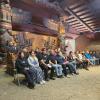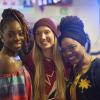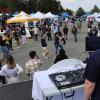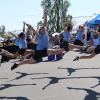
VIU Visual Arts and Psychology student Richard Harlow displays two of his touchable art pieces. The paintings are meant to be touched as well as looked at so those with vision impairments can also experience the art. The picture at the front, Secrets of Syria, is a before and after scene from a World Heritage Site in Aleppo, and the picture behind Richard is called Vision of Paradise.
August 18, 2017 - 4:15pm
VIU Visual Arts and Psychology student Richard Harlow is creating tactile art that can be experienced via touch as well as sight
A few years after Richard Harlow started to lose his vision, he began to have a reoccurring dream. In the dream, he was walking through a tropical forest and when he came out, he was on the beach and a beautiful sunset was unfolding before him. The waves were crashing gently on the sandy shores of the beach and he was at peace.
Years later, Harlow, a Vancouver Island University (VIU) Psychology and Visual Arts student, re-created his dream scene on a 6’ X 4’ canvas. The accomplishment is significant on two levels for the 28-year-old artist, actor, activist, standup comic and model. He has fulfilled his wish to get back into art after losing all of his central vision, and it also marks the beginning of a new form of art Harlow hopes will be more inclusive for the vision-impaired - art that is meant to be touched as well as seen.
“With my paintings, I’m always trying to show people that just because you have a disability, doesn’t mean you can’t accomplish anything you want to,” he says. “With my tactile art, I’m bridging the gap between people with and without vision - both are able to experience the painting and no one is excluded. In most art galleries, there are signs asking you not to touch the paintings, but with my paintings, touching is encouraged.”
In Harlow’s dream scene painting, called Vision of Paradise, people can touch the waves and feel the ripples. He mixed ground walnut shells into the paint to achieve the feeling of the sand, and the feeling of the waves rippling into shore was achieved using two types of syringes and gel paint - an idea Harlow got from a volunteering at a pop-up injection site in downtown Nanaimo.
“It’s meant to be best experienced from a seated position - so someone in a wheelchair would have the best view,” he adds.
The painting, one of the first Harlow has done in this new style, is currently displayed in VIU’s Upper Cafeteria for everyone to enjoy. It and Harlow’s other paintings are for sale via his Blind Eye Works Facebook page. He also received a bursary through the Canadian Institute for the Blind for his accessible artwork.
Michelle Liberson, spokeswoman for the Nanaimo Disability Resource Centre, says Harlow’s paintings are a way to engage others who could feel left out from the art scene.
“For those who cannot experience art through sight, they can now feel the beauty of accessible art,” she says. “It’s a positive, inclusive form of expression.”
While Harlow is happy to return to his original passion – art – the journey has been an emotional one as he relearns how to paint in a very different style than the one he was used to when he had full vision.
“At first, I kept comparing myself to what I used to do, I didn’t think I was going to be able to do it,” he remembers. “I paint in a more abstract, impressionistic way. And I mix paint from memory now – my eyes aren’t perfect with perceiving colour.”
Harlow first attended VIU right after graduating from Woodlands Secondary School in Nanaimo. He took visual arts classes here for a couple years before transferring to Emily Carr University of Art + Design in Vancouver to study 3D and classical animation, which is when he started to lose his vision due to a rare optic nerve condition. Harlow dropped out of school and returned to Nanaimo.
In 2010, he returned to VIU, this time to take psychology courses. Since then Harlow has immersed himself in advocacy work for people with disabilities, through the VIU Students’ Union, the Board of Governors and Senate, and in the community.
“Because I got my disability in my early twenties, I’ve experienced both sides,” explains Harlow. “My disability has humbled me – I’ve experienced how people with disabilities are treated differently. It’s made me want to push myself more in a sense, to see what I can overcome.”
Harlow started a disability awareness club on campus and was the driving force behind getting the University to replace the old disability icon with a new, more empowered ability icon in 2015. The City of Nanaimo followed suit, becoming the first municipality to adopt the new icon, which portrays legs, arms and body in forward motion, suggesting independence, strength, participation and the ability to overcome. Harlow was board director of the Nanaimo Disability Resource Centre at the time.
He continues his advocacy work for the visually impaired these days as host to a TV show called App TV through Accessible Media Inc. The program showcases apps that help the visually impaired gain more independence. On top of his artwork and acting, Harlow is also a standup comedian and model, and in his spare time, he trains in Brazilian jiu-jitsu.
“The thing I really like reminding people is that having a disability is not the end – it’s the beginning of a new chapter, and it’s entirely up to you to choose how to write that story,” says Harlow.
-30-
MEDIA CONTACT:
Jenn McGarrigle, Communications Officer, Vancouver Island University
P: 250.740.6559 | C: 250.619.6860 | E: jenn.mcgarrigle@viu.ca | T: @VIUNews
Tags: Student Success






